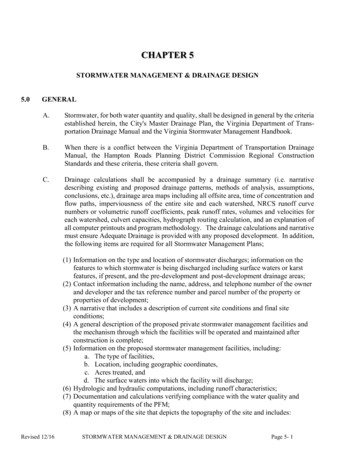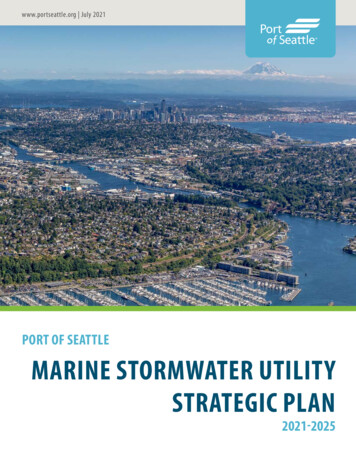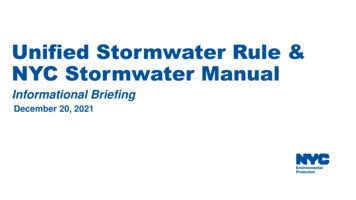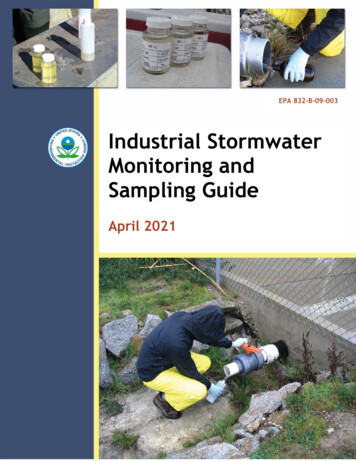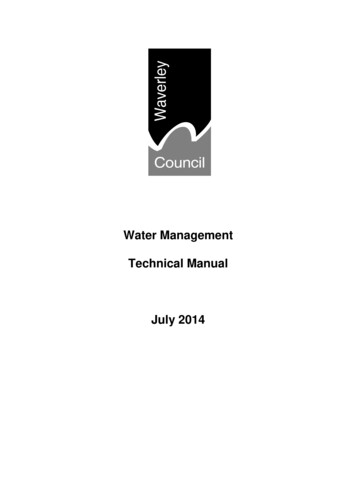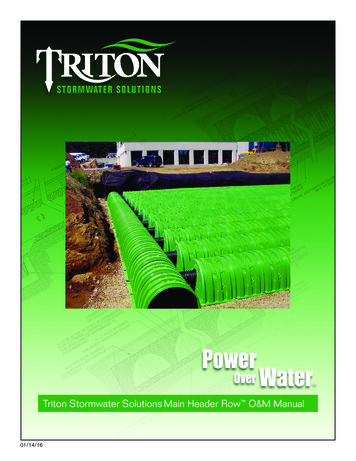
Transcription
Triton Chamber System for Stormwater Management Installation ManualTriton Stormwater Solutions Main Header Row O&M Manual01/14/16
Triton Stormwater Solutions Main Header Row O&M ManualIntroductionAn important component of any Stormwater Pollution Prevention Plan is inspection and maintenance. The Triton MainHeader Row is a patent pending technique to inexpensivelyenhance Total Suspended Solids (TSS) removal and provideeasy access for inspection and maintenance.The Main Header Row The Main Header Row is comprised of a row of any Tritonchambers that sit upon the interconnecting sediment floorsthat are connected to a closely located manhole for easy access. At the end of the Main Header Row there can be anoptional Sump Basin Assembly (Shown as item 3 in figure 2)to help collect and contain any sediment that will be flushedout of the Main Header Row during a rain event or during amaintenance cleaning. The sump basin assembly can thenbe accessed from above via a manhole or up to a 33” diameter stand pipe. The Main Header Row feeds the distributionrows (shown as item 4 in figure 2) via a feed or distributionpipe. The Feed pipe is at an elevated invert height so the water in the Main Header Row has to rise to this invert heightbefore flowing into the distribution rows thus capturing thesediments in the Main Header Row. The Main Header Row isthen protecting the distribution chamber row storage areasof any sediment accumulation. This allows for preserving theinfiltration rate of the area where the distribution rows areinstalled thus allowing the system to perform at the rate thatthe system was designed for.The sediment floors are designed to prevent scouring of theunderlying stone and to collect sediments from infiltratinginto the ground under the Main Header Row. The sedimentfloors lock together and mate with the chambers so they willremain intact during very high flow events and during highpressure cleaning.The Main Header Row is typically designed to capturethe “first flush” and offers the versatility to be sized on avolume basis or flow-rate basis. An up-stream manhole not onlyprovides access to the Main Header Row but typicallyincludes a high flow outlet such that stormwater flow rates orvolumes that exceed the capacity of the Main Header Rowcan overflow into the surrounding stone and or dischargethrough a manifold to the other chambers. The Main Header Row may also be part of a treatment train. By treatingstormwater prior to entry into the Main Header Row system,the service life can be extended and pollutants such ashydrocarbons can be captured. Pre-treatment best management practices can be as simple as deep sump catch basins,oil-water separators or can be innovative storm water treatment devices. The design of the treatment train and selectionof pretreatment devices by the de-sign engineer are oftendriven by regulatory requirements. Whether pre-treatmentis used or not, the Main Header Row is recommended byTriton as an effective means to minimize maintenancerequirements and maintenance costs.2Call Triton SWS at 810.222.7652 for technical and product information or visit www.tritonsws.com
Triton Chamber System for Stormwater Management Installation ManualTreatment Train Inspection and MaintenanceThe Triton SWS recommended treatment train inlet system has three tiers of treatment upstream of the Triton SWS chambers.It is recommended that inspection and maintenance (l&M) be initiated at the furthest upstream treatment tier and continuedownstream as necessary. The following l&M procedures follow this approach providing l&M information in the following order:Tier 1- Pre-treatment (BMP);Tier 2 - Triton SWS Main Header RowTier 3 - Eccentric Pipe Header System – This option is not needed when using the Triton system because the Main HeaderRow eliminates the need for a pipe header system.Catch Basin/Manholes I&MTypically a stormwater system will have catch basins and manholes upstream of the detention/retention system. In some casesthese may be the only pre-treatment devices. Regular l&M of catch basins and manholes should be scheduled and per-formedas part of a site's routine maintenance plan.Step-by-Step Maintenance Procedures1). Inspect catch basins and manholes upstream of Triton SWS chambersfor sediment2). Remove grate or cover3). Skim off oils and floatables4). Using a stadia rod, measure the depth of sediment5). If sediment is at a depth greater than 8" proceed to step 6. If not proceedto step 7.6). Vacuum or manually remove sediment7). Replace grate8). Record depth & date and schedule next inspectionPre-Treatment Device I&MManufacturer's l&M procedures should be followed for proprietary pretreatment devices such as baffle boxes, swirl concentrators, oil-water separators, and filtration units. Table below provides some general guidelines but is not a substitute for amanufacturer’s specific instructions.3SEDIMENT CONTROL INSPECTIONINSPECTION*MAINTENANCE**Triton Main Header RowAnnuallyJetVac-Culvert Cleaning Nozzle orHigh-Pressure HoseSediment BasinBi-Annually or after large storm eventExcavate sedimentCatch Basin SumpBi-AnnuallyExcavate, pump or vacuumSediment StructureBi-AnnuallyExcavate, pump or vacuumCatch Basin Filter BagsAfter all storm eventsClean and/or replace filter bagsPorous PavementQuarterlySweep PavementPipe Header DesignQuarterlyExcavate, pump or vacuumWater Quality InletQuarterlyExcavate, pump or vacuumTriton Filter PucksBi-AnnuallyClean and/or replace filter media in pucksCall Triton SWS at 810.222.7652 for technical and product information or visit www.tritonsws.com
Triton Chamber System for Stormwater Management Installation ManualMain Header Row InspectionThe frequency of Inspection and maintenance varies by location. A routine inspection schedule needs to be establishedfor each individual location based upon site specific variables.The type of land use (i.e. industrial, commercial, residential),anticipated pollutant load, percent imperviousness, climate,etc., all play a critical role in determining the actual frequencyof inspection and maintenance practices.If upon visual inspection it is found that sediment has accumulated, a stadia rod should be inserted to determine the depthof sediment. When the average depth of sediment exceeds8" inches in the bottom of the Sump Basin and or if there is 3"throughout the length of the Main Header Row, clean-out ofthe Sump Basin and Main Header Row should be performed.At a minimum, Triton recommends annual inspections. TheMain Header Row should be inspected every 6 months for thefirst year of operation. For subsequent years, the inspectionshould be adjusted based upon previous observation of sediment deposition.The Main Header Row incorporates a combination of standardmanhole(s) and strategically located inspection ports (as needed). The inspection ports allow for easy access to the systemfrom the surface, eliminating the need to perform a confinedspace entry for inspection purposes.Main Header Row MaintenanceThe Main Header Row was designed to reduce the cost ofperiodic maintenance. By confining sediments to just one row,costs are dramatically reduced by eliminating the need to cleanout each row of the entire storage bed. If inspection indicatesthe potential need for maintenance, access is provided via amanhole(s) located on the end(s) of the Main Header Row forcleanout. If entry into the manhole is required, please followlocal and OSHA rules for a confined-space entries. The insidedimensions of the Triton Main Header Row Chambers are 34”tall by 48” wide.and the Main Header Row but they can be cleaned using aJetVac process or can be cleaned by using a water tank truckor fire truck equipped with a hose to flush the sediment to theSump Basin if so desired. To use a water tanker or fire trucksimply insert the hose into the upstream catch basin structure and flush the sediment to the end of the main header rowwhere the Sump Basin is located. If the Sump Basin is locatedclose to the inlet, then vacuum out the sediment first and thenback flush the Main Header Row back into the Sump Basin.NOTE: The JetVac or high-pressure hose process shallonly be performed on the Main Header Row where theTriton Sediment Floor System has been installed andonly if there is 3” of sediment throughout the length ofthe Main Header Row.Maintenance is accomplished by removing the sediment thathas built up in the Sump Basin by using a standard vacuumtruck as shown to the right. The Triton Main Header Row system was designed to allow for easy access to the Sump Basinvia a manhole/inspection port up to a 33” diameter pipe. Thereis no need for a special process to clean out the Sump Basin4Call Triton SWS at 810.222.7652 for technical and product information or visit www.tritonsws.com
Triton Stormwater Solutions Main Header Row O&M ManualMain Header Row Step-by-Step Maintenance ProceduresStep 1. Inspect Sump Basin and Main HeaderRow for sedimentStep 2. Clean out the Sump Basin with a vacuumtruckA. Remove any secondary filtration media that maybe installed in the sump basinA. Inspection ports (if present)i. Remove lid from floor box frameB. Vacuum Sump Basin as requiredii. Remove cap from inspection riseriii. Using a flashlight and stadia rod, measuredepth of sediment in the Sump Basin andrecord results on maintenance log.Step 3. Replace all caps, lids, and covers. Recordobservations and actionsiv. If sediment is at or above 11-inch depth,proceed to Step 2. If not, proceed to step 3.Step 4. Inspect & clean catch basins and manholesupstream of the Triton systemB. All Main Header Rowsi. Remove cover from manhole at upstream endof Main Header Rowii. Using a flashlight, inspect the Main HeaderRow through outlet pipe and through eachdistribution pipe that is connected in betweenthe Main Header Row and the distribution rowof chambersiii. If sediment is at or above the 11" mark in thesump bin, proceed to Step 21. Be sure to have proper footing when entering intoMain Header Row.2. Follow OSHA regulations for confined space entry ifentering Main Header Row.If not, proceed to Step 3Sample Maintenance LogStadia Rod ReadingsDate4/11/2007Fixed point tochamber bottom (1)Fixed point tochamber top (2)9.7 ft.None10/21/20079.6SedimentDepth(1)-(2)0.1 ft.Observations/ActionsInspectorNew installation. Fixed point is J1 frame at gradeKETVery little sediment in system - No maintenance requiredGKTCMM4/11/20089.40.3 ft.Very little sediment in system - No maintenance required7/25/20099.10.6 ft.Some debris/sediment is visible in sump basin assembly but not interfering with outletLEJ7/20/20108.71.0 ft.Some debris/sediment is visible in sump basin assembly - maintenance is dueDLCSystem has cleaned and vacuumed - very easy system to cleanNAT8/20/20109.7 ft.0LIFETIME SYSTEM WARRANTY810-222-7652 tritonsws.com7600 Grand River Suite 195Brighton, Michigan 48114Revised 01/14/16. Supersedes all previous O&M manuals.PoweroverWater OM Manual 0311
10/21/2007 9.6 0.1 ft. Very little sediment in system - No maintenance required GKT 4/11/2008 9.4 0.3 ft. Very little sediment in system - No maintenance required CMM 7/25/2009 9.1 0.6 ft. Some debris/sediment is visible in sump basin assembly but not interfering with outlet LEJ 7/20/2010 8.7 1.0 ft.

